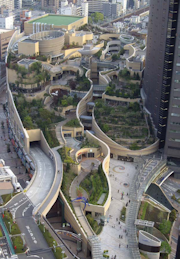Daniel K. Slone is a vocal proponent of sustainable development and he believes fervently that the “great places” where people love to work and live tend to cluster in densely populated urban areas. But the McGuireWoods attorney, who has developed a globe-trotting practice working with clients in the oft-intersecting fields of New Urbanism and the green movement, observes candidly that sustainable practices are not always easily implemented in cities, which have vast sunk investments in aging infrastructure.
Retrofitting the dense urban core of a metropolitan area for sustainability is more expensive than building green buildings and communities from scratch in open fields, Slone said during an address to the C3 breakfast club this morning in Richmond. “Every city has a bunch of junk under it” — aging pipes, underground storage tanks and the like. And cities tend to cover every square foot with buildings or pavement. All of which raises an uncomfortable question: “Are urban areas at a disadvantage going forward into a green future?”
Not necessarily. But it will take a big shift in thinking, Slone says, to make dense urban cores competitive in the race to create “regenerative cities” that consume less water, energy and other resources. The key is understanding the competitive advantage of urban areas: proximity. The close proximity that comes with density makes it far more practical to recycle water, waste water and energy.
One way to get around the necessity of expanding water/sewer/storm water infrastructure at massive cost is to adopt water harvesting strategies. Capturing, storing and utilizing rainwater for neighborhood use makes far more energy sense than pumping waste water to a central treatment plant and then pumping it back. Untreated water can be applied to lawns, plants and landscapes including green roofs and green walls. New technologies also are making it more practical to treat water on a neighborhood scale for human consumption.
Rainfall is variable, of course, and storage is expensive. “But what if, instead of storing the water, we gave it away during the rainy season?” asked Slone. What if a city like Richmond, instead of confining all manufacturing operations to industrial districts, permitted them to locate in mixed-use neighborhoods? What if a rain-harvesting neighborhood was able to provide the manufacturer free water for three months out of the year? That could give the enterprise a cost advantage it would not enjoy in a different location.
Likewise, what if the manufacturer generated a lot of waste heat? In the suburbs there is no practical alternative but to vent the heat out a smokestack. But in a mixed-use neighborhood, it is more practical to use waste heat as an energy source for district heating and cooling.
Thus, industry, which traditionally has been segregated from other land uses, could become an integral part of urban water and energy recycling. “The ability to consume one another’s waste streams becomes a competitive advantage,” said Slone.
The Richmond region is moving forward in adopting sustainability strategies. “Look around and you see more creative things happening,” Slone said. “It’s not happening fast, but it’s happening.” Unfortunately, it’s happening faster in other cities around the world, from Europe to China. If Richmond wants to become globally competitive as a region, he warned, “We have to pick up the pace.”
“If you don’t like change,” he added, quoting General Eric Shinseki, “you’re going to like irrelevance even less.”




